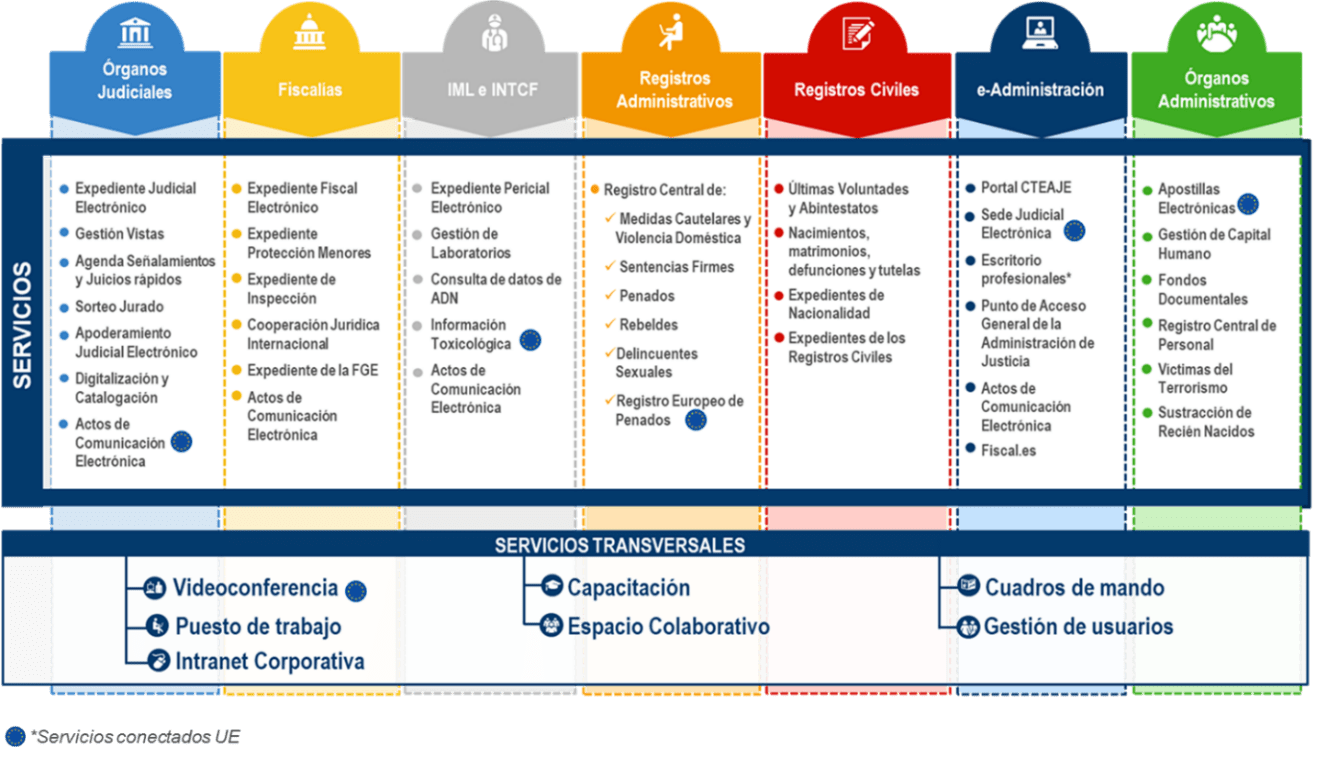Spanish justice has its technological engine in Subdireccion General de Nuevas Tecnologias de la Justicia (SGNTJ) as it is the body of the Ministry of Justice responsible for providing IT services to the Justice Administration and multiple agents that relate to same in the territory managed by the Ministry of Justice.

The table below shows a summary of the catalogue of ICT services provided by the Ministry of Justice to the Justice Administrating.

With respect to the groups and institutions most directly involved in the Justice Administration, the SGNTJ provides services to 20,000 civil servants, 29,000 users of the Support Services for the Justice Administration and Civil Registers, over 300,000 Justice professionals (lawyers, solicitors, industrial relations officials, state security forces, health centres, etc.) and the citizens in general.
To deliver all of this, the SGNTJ has a management structure comprised of 79 civil servants supported by an external structure of 800 people of private sector.
As well as the volume, complexity and diversity of the IT services provided, a fundamental element is the impact that these services have on different groups involved directly or indirectly with the Justice Administration. And also on the social assessment of Justice as a public service, the impacts that the good (or bad) functioning of these services might have on users and citizens in general.
To deliver an effective, efficient and innovative Justice Administration focused on citizens and professionals. The Ministry of Justice places digital definition and transformation of Spanish justice as goal of maximum priority.
In 2015 “El Plan para la aceleracion de la justicia en entornos digitales” (plan for the acceleration of Justice in digital environments) that leads to exponential growth in the provision of digital services: Implementation of a new IT infrastructure and the evolution of existing back-end systems, architectures geared towards service that implement full digital work flows, extensive use of digital signature, electronic Judicial Communications between professionals and courts, progressive development and implementation of integral electronic processing of judicial procedures.
The existing barriers and restrictions include:
- Geographic: the coverage of services is nationwide or even European-wide.
- Policy: The SGNTJ depends on the Ministry of Justice but provides services to the justice administration, judicial powers and the transferred communities among others.
- Legal: compulsory regulations are established directly affecting the demand for IT services: Ley 59/2003de firma electronica (electronic signatures); Ley 18/2011(setting out the commitment to making electronic processing of the legal process a reality from July 2016 on); Regulation (EU) No 910/2014 2014 (on electronic identification and trust services for electronic transactions in the internal market ); ); Ley 42/2015, and Real Decreto 1065/2015 (establishing the compulsory use of telematic technologies in the Justice Administration); Ley organica 3/2018, of 5 December, de Proteccion de Datos Personales y garant’a de los derechos digitales. (on Personal Data Protection and guaranteeing digital rights. Improvements in the security and privacy of the management of personal data).
- Technological: The information systems, software applications and all IT infrastructure that support a complex, diverse and disperse framework.
- Organizational: the SGNTJ lacks adequate dimensioning and governance of resources, putting real development of the Digital Transformation of Justice at risk.
In this context, since the beginning, the SGNTJ, conscious of the technological demands going to be place on Spanish justice and the opportunity to apply disruptive technologies (AI, blockchain) considers it necessary to generate sustainable differential value that strengthens the leadership of the Ministry of Justice making it a common and shared service provider to the Justice Administration, allowing it to advance in the integration and relations between all stakeholders in the procedural activity at the same time and in any part of the national territory and increase the availability and security of the services.
In this way, September 2016 was launched the Process Optimization Program (POP) to undertake an initiative that would allow to transform in more effective and efficient the processes that support for all the technical and technological resources that sustain the entire operational reality of the administration of justice, and to define and implement a Government model that tackles the challenges of the continuous transformation and improvement of Digital Justice.